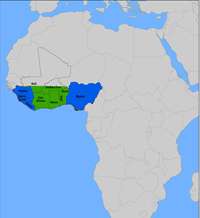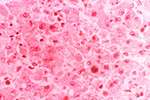Lassa virus uses unexpected two-step mechanism to enter cells

(Medical Xpress)—The Lassa virus is a dangerous microbe. Endemic to West Africa and spread by a rodent, it causes infections in humans that can lead to a severe and deadly hemorrhagic fever. There are an estimated 500,000 infections and 100,000 fatalities per year in West Africa from this fever.
More than 30 years ago, researchers discovered that while the virus can infect a broad range of cells from different species, it doesn't infect chicken cells. What makes this puzzling is that bird cells have the same cell-surface receptor as other species, a protein that the virus uses to hook onto cells and enter them. So how do birds avoid infection?
Now, an international research team comprising investigators from Harvard Medical School and the Netherlands Cancer Institute has solved this mystery, leading to a better understanding of how Lassa virus infects mammals. Using genetic screens, they determined that a second protein called LAMP1 is essential for the virus to properly infect cells. Their results were published in the journal Science on June 27.
The identification of LAMP1 as a Lassa virus receptor now presents a new target for potential intervention, said Sean Whelan, HMS professor of microbiology and immunobiology. A co-corresponding author of the paper, he noted that the research is central to work done as part of a Center of Excellence for Translational Research in virology at HMS. The center is focused on the development of small-molecule inhibitors of enveloped virus entry.
"Importantly, the work also suggests why it has been historically difficult to identify receptors for many viruses using traditional biochemical assays," he said. "By using a receptor molecule hidden on an interior membrane, the virus can sequester its potentially vulnerable receptor binding site from neutralizing antibody."

The genetic discoveries were validated in mice by a team led by John Dye at the U.S. Army Medical Research Institute of Infectious Diseases and at the University of Kiel in Germany. Mice engineered to lack the LAMP1 protein were not susceptible to the Lassa virus.
It turns out that when Lassa virus grabs onto a receptor on the cell surface, it is first transported to a structure inside the cell called a lysosome. Lysosomes are the "garbage cans" of cells, breaking down a variety of molecules in the cell's hostile interior. To infect the cell, Lassa virus needs to escape the lysosome. It does so by hooking onto LAMP1, which appears to be an unknown type of interior cell receptor for the virus.
"From a virology point of view, this second part of our discovery is the most interesting," said first author Lucas Jae of the Netherlands Cancer Institute. "The identity of the receptor on the cell surface has been known for 15 years. Nobody expected there to be a second receptor inside of the cell."
The scientists also discovered that the critical difference between the avian version of the LAMP1 protein and its human counterpart lies within a single additional sugar structure, present in humans but absent in birds.
Three years ago the team from HMS, USAMRIID and the Netherlands Cancer Institute, together with Kartik Chandran at Albert Einstein College of Medicine, found a similar two-step mechanism for the entry of Ebola virus into cells.
"We now suspect that more viruses may require multiple receptors to reach the cytoplasm," said Thijn Brummelkamp, a co-corresponding author of the current Science paper. "If this turns out to be true, the process by which viruses infect cells is more complicated than currently stated in the textbooks."
More information: Lassa virus entry requires a trigger-induced receptor switch, by L.T. Jae; M. Raaben et al. www.sciencemag.org/lookup/doi/ … 1126/science.1252480

















